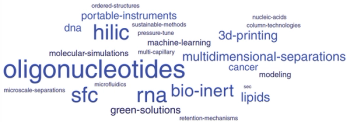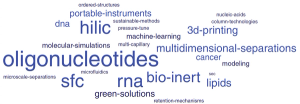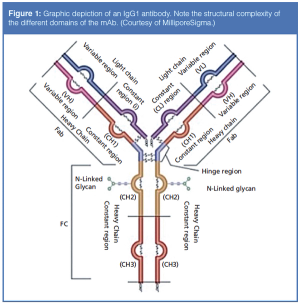
This “Column Watch” installment presents many of the highlighted topics and trends observed at the 52nd International Symposium on High Performance Liquid Phase Separations and Related Techniques (HPLC 2024).
Cory E. Muraco is the Biomolecule Workflows Manager at MilliporeSigma, the life science business of Merck KGaA. After finishing his graduate studies at Youngstown State University (Youngstown, Ohio, USA), Cory started his career at MilliporeSigma in 2013. After holding several roles in both R&D and Marketing functions, in 2022, Cory assumed his current role as the Biomolecule Workflows Manager where he is tasked with designing, developing, and executing the marketing and R&D strategies around MilliporeSigma’s bioanalytical initiative. Cory is the author of several manuscripts appearing in trade magazines and has delivered over 100 presentations at international conferences, roundtable symposia, and at various pharmaceutical and biopharmaceutical companies.

This “Column Watch” installment presents many of the highlighted topics and trends observed at the 52nd International Symposium on High Performance Liquid Phase Separations and Related Techniques (HPLC 2024).

This paper describes advances in column design that enable the analyst to achieve high sensitivity and efficiency when reducing the internal diameter of the column.

When the unique shape-selective properties of PGC are appropriately identified, PGC stationary phases can be harnessed for fine separations of structurally related compounds.

At HPLC 2022, we heard about new research and developments, in areas such as column technologies, portable instrumentation, and machine learning, among others.

This instalment of “Column Watch” presents many of the highlighted topics and trends observed at the symposium.

The strategies described here can improve the efficiency and analyte recovery of chromatographic methods used to characterize monoclonal antibodies and antibody– drug conjugates.

Biotherapeutics have become the hottest topic in pharmaceutical research over the past decade. With the increased interest in biotherapeutics, there has been a concomitant increase in new analytical methods for characterizing these large, complex molecules. This installment of “Column Watch” discusses advances in “bottom-up” analysis of monoclonal antibodies, while highlighting the role and importance column chemistry still plays in developing highly selective high-performance liquid chromatography (HPLC) methods for peptides.

Biotherapeutics have become the hottest topic in pharmaceutical research over the past decade. With the increased interest in biotherapeutics, there has been a concomitant increase in new analytical methods for characterizing these large, complex molecules. This installment of “Column Watch” discusses advances in “bottom-up” analysis of monoclonal antibodies, while highlighting the role and importance column chemistry still plays in developing highly selective high-performance liquid chromatography (HPLC) methods for peptides.

New strategies for “bottom-up” analysis of therapeutic proteins, using faster enzymes, new buffer systems, and optimal column chemistries, enable analysts to perform these studies much faster and with fewer artifacts.

The 47th International Symposium on High Performance Liquid Phase Separations and Related Techniques (HPLC 2018), chaired by Norman Dovichi, was held from 29 July to 2 August in Washington, D.C., USA. This instalment of “Column Watch” covers some of the highlights observed at the symposium. In addition, trends and perspectives on future developments in HPLC noted from the conference are presented.

The 47th International Symposium on High Performance Liquid Phase Separations and Related Techniques (HPLC 2018), chaired by Norman Dovichi, was held from 29 July to 2 August in Washington, D.C., USA. This instalment of “Column Watch” covers some of the highlights observed at the symposium. In addition, trends and perspectives on future developments in HPLC noted from the conference are presented.

Topics that stood out at HPLC 2018 include advances in large-molecule separations, multidimensional separations, 3D printing, chiral separations, and HILIC. Also, many speakers addressed separation fundamentals, including ways to increase speed, generate higher throughput, and add selectivity.

To resolve and quantitate monoclonal antibodies and antibody–drug conjugates, analytical scientists need various chromatographic modes, such as sizeexclusion, ion-exchange, hydrophobic interaction, and hydrophilic interaction chromatography. Here, we provide advice for making the most of each mode.

Separating proteins and antibodies is a unique analytical challenge because of the complexity of the analytes. Both sample heterogeneity, because of a number of chemical modifications to the analyte, and nonspecific binding to the silica surface often result in chromatographic peak broadening and tailing. This instalment of “Column Watch” focuses on several different chromatographic strategies that analytical scientists can use to resolve and quantitate various biomacromolecules, including monoclobal antibodies (mAbs) and antibody–drug conjugates (ADCs). Selected aspects of size-exclusion, hydrophobic interaction, ion-exchange, hydrophilic interaction, and reversed-phase chromatography are discussed.

Published: September 1st 2022 | Updated:

Published: September 12th 2024 | Updated:

Published: September 1st 2022 | Updated:

Published: April 1st 2023 | Updated:

Published: October 1st 2017 | Updated:

Published: October 1st 2017 | Updated: